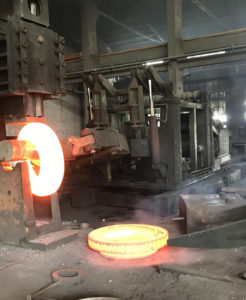Casting flange has accurate shape and size, small workload and low cost, but it has casting defects (pore, crack, inclusion); poor streamlined internal structure of casting (if it is a cutting piece, the streamlined shape is worse); forging flange generally contains less carbon than casting flange and is not easy to rust; forging flange has better streamlined shape, compact structure and mechanical properties. The properties of the flange are better than those of the casting flange, and the improper forging process will lead to large or uneven grains, hardening cracks and higher forging cost than that of the casting flange.

Forgings can withstand higher shear and tensile forces than castings. The advantages of castings are that they can produce more complex shapes and lower costs; and the internal structure is uniform, and there are no harmful defects such as blowhole and inclusion; casting flange and forging flange can be distinguished from production process, such as centrifugal flange, which belongs to casting flange.
Centrifugal flange belongs to precision casting method. Compared with common sand casting, this casting method has much finer structure and much better quality. It is not easy to have loose structure, pore and trachoma.
Production Process of Forging Flange
Select high quality billet blanking, heating, forming and cooling after forging. The forging process includes free forging, die forging and die forging. In production, different forging methods are selected according to the quality and quantity of forgings.
The basic process of free forging: when forging freely, the shape of forgings is gradually forged by some basic deformation processes. The basic processes of free forging include upsetting, drawing, punching, bending and cutting.
Upsetting is the process of forging the billet along the axis to reduce its height and increase its cross section. This process is often used to forge gear blanks and other disc forgings. Upsetting can be divided into two types: total upsetting and local upsetting.
Drawing is a forging process that increases the length of blank and decreases the cross section. It is usually used to produce axle blanks, such as lathe spindle and connecting rod.
The forging process of punching through hole or non-through hole on blank with punch.
A forging process in which billets are bent to an angle or shape by bending.
A forging process in which a part of the billet rotates at a certain angle relative to another part by torsion.
The forging process of cutting and cutting blank or cutting blank head.
Die forging is called model forging, which is formed by placing the heated billet in the forging die fixed on the die forging equipment. Basic processes: blanking, heating, pre-forging, final forging, punching, trimming, tempering, shot peening. Common processes include upsetting, drawing, bending, punching and forming. Common die forging equipments include die forging hammer, hot die forging press, flat forging press and friction press. Generally speaking, the quality of forged flange is better. It is usually produced by die forging. The crystal structure is fine and the strength is high. Of course, the price is more expensive.
Cutting flange
In the middle plate, the flange is directly cut out of the disc with the inside and outside diameter and thickness of the processing quantity, and then the bolt hole and the water line are processed. The flange thus produced is called cutting flange. The maximum diameter of such flange is limited to the width of the plate.
Rolled flange
The process of cutting strips with medium plates and rolling them into circles is called rolling, which is mostly used in the production of some large flanges. After successful coiling, welding is carried out, then flattening is carried out, and then the process of water line and bolt hole is processed.
